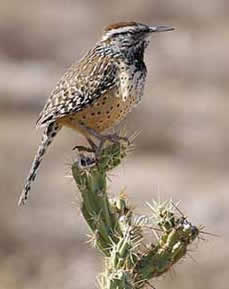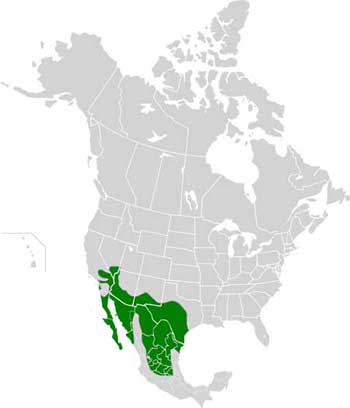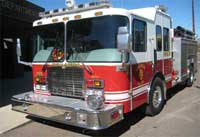BY JIM BLACKBURN | NOVEMBER 30, 2011
 Who’d Choose a Cactus Wren as Arizona’s State Bird?
Who’d Choose a Cactus Wren as Arizona’s State Bird?
A unique and independent character
When I was a kid in Ohio one of the best little songsters around was the wren. My mother loved wrens and tried to mimic their whistle. She encouraged me when I built birdhouses to make sure the hole was small enough so “those pesky English sparrows” couldn’t get in. Most wrens are rather small.
 But our southwestern Cactus Wren (Campylorhynchus brunneicapillus) is a whopping 6” to 8½” long. It has the distinction of being the biggest member of the wren family, larger than an English sparrow and a little more streamlined. It has a medium-long and narrow beak suitable for dining on insects, berries and seeds. (Birds with shorter and stronger beaks are mostly seedeaters.) Unlike the eastern wrens with their tails in the air, the western Cactus Wren holds his tail down.
But our southwestern Cactus Wren (Campylorhynchus brunneicapillus) is a whopping 6” to 8½” long. It has the distinction of being the biggest member of the wren family, larger than an English sparrow and a little more streamlined. It has a medium-long and narrow beak suitable for dining on insects, berries and seeds. (Birds with shorter and stronger beaks are mostly seedeaters.) Unlike the eastern wrens with their tails in the air, the western Cactus Wren holds his tail down.
It’s not particularly pretty either – no bright, showy hues – just basically brown and buff with white streaks and spots above and darker spots below. The crown is dark, with “eyebrows” long and white.
Doesn’t sing too well either. In fact, it’s usually rather raucous, sassy, and noisy. Once you hear one “sing” you’ll know what I mean.
It’s also very interested and curious about what’s happening in its environment and displays an aggressive attitude in exploring nooks and crannies for fun! Much more conspicuous than any English sparrow I’ve watched.
For example, my studio shop is a double garage with door open while I’m working. In July and August there are a lot of flies (as I live on the “ horsy” side of Black Mountain). Many of these pests get swatted on the workbench and swept off to the floor. Often in the afternoons a curious Cactus Wren that must have checked out my habits ambles in, working its way under the bench to do the cleanup. Neither the work bench top nor the surrounding storage shelves offer the appetite appeal that the floor does around my feet. The wren takes only a few minutes to enjoy a fine luncheon. He’ll return around noon the next day for the same fare.
Early in the morning when I’m enjoying a cigarette on the deck, the wren nonchalantly comes by, then hops up to the windowsill behind me to clean up the insects that were attracted to the light in the window the night before and expired there.
Pack rats are fun to watch but can be a nasty nuisance, especially when they get into my cars and chew the wiring. I resorted to a live trap (Havahart brand), and with a little peanut butter bait place it under a car. Never caught a pack rat but have had a string of fearless and curious Cactus Wren releases.
Marla, my wife, loves flowers and has put together two hanging baskets just a few feet from one another outside the large windows of the bedroom and TV room where she enjoys watching the parade of snakes, lizards, pack rats and javelina as she studies the latest TV arts and crafts programs. Wouldn’t you know, a Cactus Wren claimed her basket in which to build a nest. Pecked away and scattered moss on the deck, then added string, twigs, etc., to the nest around the flower. Marla waters every day or so by taking down the basket and our wren flutters around in protest. Marla is wondering whether to chase it away and enjoy the blossoms or sacrifice the flower to watch the wrens raise a family.
 But she may be disappointed, as male wrens are renowned for building several nests each season, not just for brooding but for cozy sleeping, especially in cooler temperatures. It might be a diversionary tactic too. Interesting that the wren should pick our hanging basket. Usually nests are constructed in a Cholla cactus or Palo Verde trees. The nests resemble a football in size and shape, rough on the outside but smoothly insulated on the inside. The entry is wren size at one end. We’ve got several around the yard.
But she may be disappointed, as male wrens are renowned for building several nests each season, not just for brooding but for cozy sleeping, especially in cooler temperatures. It might be a diversionary tactic too. Interesting that the wren should pick our hanging basket. Usually nests are constructed in a Cholla cactus or Palo Verde trees. The nests resemble a football in size and shape, rough on the outside but smoothly insulated on the inside. The entry is wren size at one end. We’ve got several around the yard.
Books tell me the female selects one of the nests built by the male, finishes the inside and lays three to seven eggs, salmon colored and spotted with brown, though I’ve never investigated. I’m told they hatch in 16 days and leave the nest in about another 21 days. Mom and dad pitch in with feeding chores.
The Cactus Wren’s habitat is the scrub forest of the upper Sonoran Desert under 4,000 feet.
The Cactus Wren was proposed by Maricopa Representatives Decker and Phillips and with no opposition was voted as the Arizona State bird on March 16, 1931.
Who’d choose this unlikely wren to represent Arizona as its state bird, and why? Couldn’t be for its song, couldn’t be for its beauty, couldn’t be for its size, but – it’s my belief the southwestern Cactus Wren was selected for its unique and independent character.
NOVEMBER 30, 2011
The buzz on Arizona’s bees and a honey-tasting!!!
 CAREFREE – Honeybees have long provided humans with honey and beeswax. They play a major role in plant pollination and are also important, if not essential, for the production of billions of dollars worth of agricultural crops produced annually in Arizona. Come learn about the biology of bees, their fascinating behavior, and the role of Arizona’s native plants in bee life.
CAREFREE – Honeybees have long provided humans with honey and beeswax. They play a major role in plant pollination and are also important, if not essential, for the production of billions of dollars worth of agricultural crops produced annually in Arizona. Come learn about the biology of bees, their fascinating behavior, and the role of Arizona’s native plants in bee life.
We all have heard of the real dangers facing honeybees. What is Colony Collapse Disorder and what can be done about it? What are the dangers bees present to humans? What do we do about them and when should we be concerned? How do we treat bee stings? How can we keep our homes safe from Africanized honeybees?
And, did we mention honey-tasting?! Bring along your sweet tooth and sample a variety of honey. Only Winnie the Pooh could be happier! You may be inspired to take away some tips on the various uses of honey or how to raise you own honeybees.
The Carefree Desert Gardens invites you to spend an enjoyable morning with long-time Master Gardeners Mike Hills and Lee Ann Aronson. Mike studied Agronomy and Plant Sciences at the University of Arizona and has raised honeybees since childhood. Lee Ann is newsletter editor of the Arizona Herb Association.
The program begins at 9:30 a.m. on Saturday, December 10 and will run approximately until noon at the Town Council Chambers located in the U.S. Post Office Building, 100 Easy Street, Carefree. As their goal is to be self-supporting, a $5 (or more) donation is appreciated. Seating is limited, so arrive early. For information call 480-488-3686.
Courtesy photo: Scott Bauer, USDA/Agricultural Research Services
NOVEMBER 30, 2011
Firefighter Holiday Toy Drive!
 Rural/Metro Firefighters will be collecting new, unwrapped toys daily now through December 17 from 8 a.m. – 7 p.m. Help us make the holidays a little brighter for families in our community who are just having a tough time in today’s economy. It only takes a few minutes of your time to share some generosity with those in need.
Rural/Metro Firefighters will be collecting new, unwrapped toys daily now through December 17 from 8 a.m. – 7 p.m. Help us make the holidays a little brighter for families in our community who are just having a tough time in today’s economy. It only takes a few minutes of your time to share some generosity with those in need.
 Toy Drop Locations:
Toy Drop Locations:
Carefree-Rural/Metro Fire Station #1 at 37401 N. Tom Darlington Drive, Carefree
Cave Creek-Rural/Metro Fire Station #825 at 37402 N. Cave Creek Road, Cave Creek
Toy Ideas:
Sports equipment, pop-up books, action figures, electronic games, craft kits, art sets, crib toys, board games, stuffed animals and light up toys






 PHOENIX – On Monday, December 5, 2011, Maricopa County Sheriff Joe Arpaio will speak and personally visit with community members. The event, “An Evening with Sheriff Joe” is being held to raise urgently needed funds for the horses in the care of Conquistador Equine Rescue & Advocacy Program (CERAP).
PHOENIX – On Monday, December 5, 2011, Maricopa County Sheriff Joe Arpaio will speak and personally visit with community members. The event, “An Evening with Sheriff Joe” is being held to raise urgently needed funds for the horses in the care of Conquistador Equine Rescue & Advocacy Program (CERAP).